Multi-Objective Calibration of a Distributed Hydrological Model in a Highly Glacierized Watershed in Central Asia
Abstract
1. Introduction
2. Study Area and Hydrological Model
2.1. Study Area
2.2. SWAT Model and Glacier Module
2.3. Data Collection
3. Methodology
3.1. Sensitivity Analysis Techniques
3.1.1. Morris Method
3.1.2. State-Dependent Parameter Method (SDP)
3.2. Multi-Objective Calibration
4. Results
4.1. Sensitivity Analysis
4.2. Multi-Objective Optimization
4.3. Model Performance
5. Discussion
5.1. Glacier Melt Contribution
5.2. On Objective Functions
5.3. About SWAT_Glacier and Input Data
6. Conclusions
Supplementary Materials
Author Contributions
Funding
Conflicts of Interest
References
- Lutz, A.F.; Immerzeel, W.W.; Shrestha, A.B.; Bierkens, M.F.P. Consistent increase in High Asia’s runoff due to increasing glacier melt and precipitation. Nat. Clim. Chang. 2014, 4, 587–592. [Google Scholar] [CrossRef]
- Immerzeel, W.W.; van Beek, L.P.H.; Bierkens, M.F.P. Climate change will affect the Asian water towers. Science 2010, 328, 1382–1385. [Google Scholar] [CrossRef] [PubMed]
- Chen, Y.; Li, W.; Deng, H.; Fang, G.; Li, Z. Changes in Central Asia’s water tower: Past, present and future. Sci. Rep. 2016, 6. [Google Scholar] [CrossRef] [PubMed]
- Liu, M.; Wen, J.; Tan, G.; Liu, G.; Wu, B. Experimental studies and pilot plant tests for acid leaching of low-grade copper oxide ores at the Tuwu Copper Mine. Hydrometallurgy 2016, 165, 227–232. [Google Scholar] [CrossRef]
- Bolch, T. Hydrology: Asian glaciers are a reliable water source. Nature 2017, 545, 161. [Google Scholar] [CrossRef]
- Duethmann, D.; Bolch, T.; Farinotti, D.; Kriegel, D.; Vorogushyn, S.; Merz, B.; Pieczonka, T.; Jiang, T.; Su, B.; Güntner, A. Attribution of streamflow trends in snow and glacier melt-dominated catchments of the Tarim River, Central Asia. Water Resour. Res. 2015, 51, 4727–4750. [Google Scholar] [CrossRef]
- Gan, R.; Luo, Y.; Zuo, Q.T.; Sun, L. Effects of projected climate change on the glacier and runoff generation in the Naryn River Basin, Central Asia. J. Hydrol. 2015, 523, 240–251. [Google Scholar] [CrossRef]
- Farinotti, D.; Longuevergne, L.; Moholdt, G.; Duethmann, D.; Mölg, T.; Bolch, T.; Vorogushyn, S.; Güntner, A. Substantial glacier mass loss in the Tien Shan over the past 50 years. Nat. Geosci. 2015, 8, 716–722. [Google Scholar] [CrossRef]
- Liu, Q.; Liu, S.Y. Response of glacier mass balance to climate change in the Tianshan Mountains during the second half of the twentieth century. Clim. Dyn. 2016, 46, 303–316. [Google Scholar] [CrossRef]
- Meng, F.; Liu, T.; Huang, Y.; Luo, M.; Bao, A.; Hou, D. Quantitative detection and attribution of runoff variations in the Aksu River Basin. Water 2016, 8, 338. [Google Scholar] [CrossRef]
- Zhang, Q.; Xu, C.Y.; Tao, H.; Jiang, T.; Chen, Y.D. Climate changes and their impacts on water resources in the arid regions: A case study of the Tarim River basin, China. Stoch. Environ. Res. Risk Assess. 2010, 24, 349–358. [Google Scholar] [CrossRef]
- Shen, Y.-J.; Shen, Y.; Fink, M.; Kralisch, S.; Chen, Y.; Brenning, A. Trends and variability in streamflow and snowmelt runoff timing in the southern Tianshan Mountains. J. Hydrol. 2018, 557, 173–181. [Google Scholar] [CrossRef]
- Sun, M.; Li, Z.; Yao, X.; Zhang, M.; Jin, S. Modeling the hydrological response to climate change in a glacierized high mountain region, northwest China. J. Glaciol. 2015, 61, 127–136. [Google Scholar] [CrossRef]
- Fang, G.H.; Yang, J.; Chen, Y.N.; Zammit, C. Comparing bias correction methods in downscaling meteorological variables for a hydrologic impact study in an arid area in China. Hydrol. Earth Syst. Sci. 2015, 19, 2547–2559. [Google Scholar] [CrossRef]
- Immerzeel, W.W.; Lutz, A.; Droogers, P. Climate Change Impacts on the Upstream Water Resources of the Amu and Syr Darya River Basins; FutureWater: Wageningen, The Netherlands, 2012. [Google Scholar]
- Fan, Y.; Chen, Y.; Li, W. Increasing precipitation and baseflow in Aksu River since the 1950s. Quat. Int. 2014, 336, 26–34. [Google Scholar] [CrossRef]
- Krysanova, V.; Wortmann, M.; Bolch, T.; Merz, B.; Duethmann, D.; Walter, J.; Huang, S.; Tong, J.; Buda, S.; Kundzewicz, Z.W. Analysis of current trends in climate parameters, river discharge and glaciers in the Aksu River basin (Central Asia). Hydrol. Sci. J. 2015, 60, 566–590. [Google Scholar] [CrossRef]
- Wang, X.; Luo, Y.; Sun, L.; Zhang, Y. Assessing the effects of precipitation and temperature changes on hydrological processes in a glacier-dominated catchment. Hydrol. Process. 2015, 29, 4830–4845. [Google Scholar] [CrossRef]
- Zhao, Q.D.; Zhang, S.Q.; Ding, Y.J.; Wang, J.; Han, H.D.; Xu, J.L.; Zhao, C.C.; Guo, W.Q.; Shangguan, D.H. Modeling hydrologic response to climate change and shrinking glaciers in the highly glacierized Kunma Like River Catchment, Central Tian Shan. J. Hydrometeorol. 2015, 16, 2383–2402. [Google Scholar] [CrossRef]
- Saltelli, A.; Ratto, M.; Tarantola, S.; Campolongo, F. Update 1 of: Sensitivity analysis for chemical models. Chem. Rev. 2012, 112, 1–21. [Google Scholar] [CrossRef]
- Annoni, P.; Bruggemann, R.; Saltelli, A. Random and quasi-random designs in variance-based sensitivity analysis for partially ordered sets. Reliab. Eng. Syst. Saf. 2012, 107, 184–189. [Google Scholar] [CrossRef]
- Ferretti, F.; Saltelli, A.; Tarantola, S. Trends in sensitivity analysis practice in the last decade. Sci. Total Environ. 2016, 568, 666–670. [Google Scholar] [CrossRef] [PubMed]
- Havel, A.; Tasdighi, A.; Arabi, M. Assessing the hydrologic response to wildfires in mountainous regions. Hydrol. Earth Syst. Sci. 2018, 22, 2527–2550. [Google Scholar] [CrossRef]
- Pathiraja, S.; Anghileri, D.; Burlando, P.; Sharma, A.; Marshall, L.; Moradkhani, H. Time-varying parameter models for catchments with land use change: The importance of model structure. Hydrol. Earth Syst. Sci. 2018, 22, 2903–2919. [Google Scholar] [CrossRef]
- Singh, V.; Kumar Goyal, M.; Surampalli, R.Y.; Munoz-Arriola, F. Sub catchment assessment of snowpack and snowmelt change by analyzing elevation bands and parameter sensitivity in the high Himalayas. Hydrol. Earth Syst. Sci. Discuss. 2017, 1–31. [Google Scholar] [CrossRef]
- Zhao, Q.D.; Ye, B.S.; Ding, Y.J.; Zhang, S.Q.; Yi, S.H.; Wang, J.; Shangguan, D.H.; Zhao, C.C.; Han, H.D. Coupling a glacier melt model to the Variable Infiltration Capacity (VIC) model for hydrological modeling in north-western China. Environ. Earth Sci. 2013, 68, 87–101. [Google Scholar] [CrossRef]
- Guo, W.; Liu, S.; Xu, J.; Wu, L.; Shangguan, D.; Yao, X.; Wei, J.; Bao, W.; Yu, P.; Liu, Q.; et al. The second Chinese glacier inventory: Data, methods and results. J. Glaciol. 2015, 61, 357–372. [Google Scholar] [CrossRef]
- Arnold, J.; Srinivasan, R.; Muttiah, R.; Williams, J. Large area hydrologic modeling and assessment—Part 1: Model development. J. Am. Water Resour. Assoc. 1998, 34, 73–89. [Google Scholar] [CrossRef]
- Sahoo, S.; Dhar, A.; Debsarkar, A.; Kar, A. Impact of water demand on hydrological regime under climate and LULC change scenarios. Environ. Earth Sci. 2018, 77. [Google Scholar] [CrossRef]
- Xu, H.; Brown, D.G.; Steiner, A.L. Sensitivity to climate change of land use and management patterns optimized for efficient mitigation of nutrient pollution. Clim. Chang. 2018. [Google Scholar] [CrossRef]
- Bajracharya, A.R.; Bajracharya, S.R.; Shrestha, A.B.; Maharjan, S.B. Climate change impact assessment on the hydrological regime of the Kaligandaki Basin, Nepal. Sci. Total Environ. 2018, 625, 837–848. [Google Scholar] [CrossRef]
- Pesce, M.; Critto, A.; Torresan, S.; Giubilato, E.; Santini, M.; Zirino, A.; Ouyang, W.; Marcomini, A. Modelling climate change impacts on nutrients and primary production in coastal waters. Sci. Total Environ. 2018, 628–629, 919–937. [Google Scholar] [CrossRef]
- Me, W.; Abell, J.M.; Hamilton, D.P. Effects of hydrologic conditions on SWAT model performance and parameter sensitivity for a small, mixed land use catchment in New Zealand. Hydrol. Earth Syst. Sci. 2015, 19, 4127–4147. [Google Scholar] [CrossRef]
- Arnold, J.G.; Allen, P.M.; Morgan, D.S. Hydrologic model for design and constructed wetlands. Wetlands 2001, 21, 167–178. [Google Scholar] [CrossRef]
- Guo, T.; Gitau, M.; Merwade, V.; Arnold, J.; Srinivasan, R.; Hirschi, M.; Engel, B. Comparison of performance of tile drainage routines in SWAT 2009 and 2012 in an extensively tile-drained watershed in the Midwest. Hydrol. Earth Syst. Sci. 2018, 22, 89–110. [Google Scholar] [CrossRef]
- Hock, R. Temperature index melt modelling in mountain areas. J. Hydrol. 2003, 282, 104–115. [Google Scholar] [CrossRef]
- Radić, V.; Hock, R. Regionally differentiated contribution of mountain glaciers and ice caps to future sea-level rise. Nat. Geosci. 2011, 4, 91–94. [Google Scholar] [CrossRef]
- Griessinger, N.; Seibert, J.; Magnusson, J.; Jonas, T. Assessing the benefit of snow data assimilation for runoff modeling in Alpine catchments. Hydrol. Earth Syst. Sci. 2016, 20, 3895–3905. [Google Scholar] [CrossRef]
- Ayala, A.; Pellicciotti, F.; MacDonell, S.; McPhee, J.; Burlando, P. Patterns of glacier ablation across North-Central Chile: Identifying the limits of empirical melt models under sublimation-favorable conditions. Water Resour. Res. 2017, 53, 5601–5625. [Google Scholar] [CrossRef]
- Kang, S.; Wang, F.; Morgenstern, U.; Zhang, Y.; Grigholm, B.; Kaspari, S.; Schwikowski, M.; Ren, J.; Yao, T.; Qin, D.; et al. Dramatic loss of glacier accumulation area on the Tibetan Plateau revealed by ice core tritium and mercury records. Cryosphere 2015, 9, 1213–1222. [Google Scholar] [CrossRef]
- Kehrwald, N.M.; Thompson, L.G.; Tandong, Y.; Mosley-Thompson, E.; Schotterer, U.; Alfimov, V.; Beer, J.; Eikenberg, J.; Davis, M.E. Mass loss on Himalayan glacier endangers water resources. Geophys. Res. Lett. 2008, 35. [Google Scholar] [CrossRef]
- Pfeffer, W.; Arendt, A.; Bliss, A.; Bolch, T.; Cogley, J.; Gardner, A.; Sharp, M. The Randolph Glacier Inventory a globally complete inventory of glaciers. J. Glaciol. 2014, 60, 537–552. [Google Scholar] [CrossRef]
- Su, Z.; Ding, L.; Liu, C. Tianshan glacier thickness and its reserve calculation. Xinjiang Geogr. 1984, 7, 37–44. (In Chinese) [Google Scholar] [CrossRef]
- Morris, M.D. Factorial sampling plans for preliminary computational experiments. Technometrics 1991, 33, 161–174. [Google Scholar] [CrossRef]
- Saltelli, A.; Ratto, M.; Andres, T.; Campolongo, F.; Cariboni, J.; Gatelli, D.; Saisana, M.; Tarantola, S. Global Sensitivity Analysis: The Primer; John Wiley: Hoboken, NJ, USA, 2008. [Google Scholar]
- Yang, J.; Castelli, F.; Chen, Y. Multiobjective sensitivity analysis and optimization of distributed hydrologic model MOBIDIC. Hydrol. Earth Syst. Sci. 2014, 18, 4101–4112. [Google Scholar] [CrossRef]
- Yang, J.; Liu, Y.; Yang, W.; Chen, Y. Multi-objective sensitivity analysis of a fully distributed hydrologic model WetSpa. Water Resour. Manag. 2011, 26, 109–128. [Google Scholar] [CrossRef]
- Hamdia, K.M.; Ghasemi, H.; Zhuang, X.; Alajlan, N.; Rabczuk, T. Sensitivity and uncertainty analysis for flexoelectric nanostructures. Comput. Methods Appl. Mech. Eng. 2018, 337, 95–109. [Google Scholar] [CrossRef]
- Kalcic, M.M.; Chaubey, I.; Frankenberger, J. Defining Soil and Water Assessment Tool (SWAT) hydrologic response units (HRUs) by field boundaries. Int. J. Agric. Biol. Eng. 2015, 8, 69–80. [Google Scholar] [CrossRef]
- Sebek, J.; Albin, N.; Bortel, R.; Natarajan, B.; Prakash, P. Sensitivity of microwave ablation models to tissue biophysical properties: A first step toward probabilistic modeling and treatment planning. Med Phys. 2016, 43. [Google Scholar] [CrossRef]
- Yang, H.; Wen, J.; Wang, S.; Li, Y. Thermal design and optimization of plate-fin heat exchangers based global sensitivity analysis and NSGA-II. Appl. Therm. Eng. 2018, 136, 444–453. [Google Scholar] [CrossRef]
- Ratto, M.; Pagano, A.; Young, P. State Dependent Parameter metamodelling and sensitivity analysis. Comput. Phys. Commun. 2007, 177, 863–876. [Google Scholar] [CrossRef]
- Sobol, I.M. Global sensitivity indices for nonlinear mathematical models and their Monte Carlo estimates. Math. Comput. Simul. 2001, 55, 271–280. [Google Scholar] [CrossRef]
- Deb, K.; Agrawal, S.; Pratap, A.; Meyarivan, T. A Fast Elitist Non-Dominated Sorting Genetic Algorithm for Multi-Objective Optimization: NSGA-II; Springer: Berlin/Heidelberg, Germany, 2000; pp. 849–858. [Google Scholar]
- Tang, Y.; Reed, P.M.; Kollat, J.B. Parallelization strategies for rapid and robust evolutionary multiobjective optimization in water resources applications. Adv. Water Resour. 2007, 30, 335–353. [Google Scholar] [CrossRef]
- Shah, R.; Reed, P. Comparative analysis of multiobjective evolutionary algorithms for random and correlated instances of multiobjective d-dimensional knapsack problems. Eur. J. Oper. Res. 2011, 211, 466–479. [Google Scholar] [CrossRef]
- Yin, Z.; Feng, Q.; Liu, S.; Zou, S.; Li, J.; Yang, L.; Deo, R. The spatial and temporal contribution of glacier runoff to watershed discharge in the Yarkant River Basin, Northwest China. Water 2017, 9, 159. [Google Scholar] [CrossRef]
- Yang, J.; Reichert, P.; Abbaspour, K.C.; Yang, H. Hydrological modelling of the chaohe basin in china: Statistical model formulation and Bayesian inference. J. Hydrol. 2007, 340, 167–182. [Google Scholar] [CrossRef]
- Neitsch, S.L.; Arnold, J.G.; Kiniry, J.R.; Williams, J.R. Soil and Water Assessment Tool Theoretical Documentation Version 2009; Texas Water Resources Institute: College Station, TX, USA, 2009. [Google Scholar]
- Moriasi, D.N.; Arnold, J.G.; Van Liew, M.W.; Bingner, R.L.; Harmel, R.D.; Veith, T.L. Model evaluation guidelines for systematic quantification of accuracy in watershed simulations. Trans. ASABE 2007, 50, 885–900. [Google Scholar] [CrossRef]
- Ai, Z.; Yang, Y.; Wang, Q.; Manevski, K.; Wang, Q.; Hu, Q.; Eer, D.; Wang, J. Characteristics and influencing factors of crop coefficient for drip-irrigated cotton under plastic-mulched condition in arid environment. J. Agric. Meteorol. 2018, 74, 1–8. [Google Scholar] [CrossRef]
- Chen, H.; Chen, Y.; Li, W.; Li, Z. Quantifying the contributions of snow/glacier meltwater to river runoff in the Tianshan Mountains, Central Asia. Glob. Planet. Chang. 2019, 174, 47–57. [Google Scholar] [CrossRef]
- Yang, Z. Glacier water resources in China. Nat. Resour. 1987, 46–55, 68. (In Chinese) [Google Scholar]
- Gupta, H.V.; Sorooshian, S.; Yapo, P.O. Toward improved calibration of hydrologic models: Multiple and noncommensurable measures of information. Water Resour. Res. 1998, 34, 751–763. [Google Scholar] [CrossRef]
- Shen, Y.; Wang, G.; Ding, Y.; Mao, W.; Liu, S.; Wang, S.; Mamatkanov, D.M. Changes in glacier mass balance in watershed of Sary Jaz-Kumarik Rivers of Tianshan Mountains in 1957–2006 and their impact on water resources and trend to end of the 21th century. J. Glaciol. Geocryol. 2009, 31, 790r800. [Google Scholar]
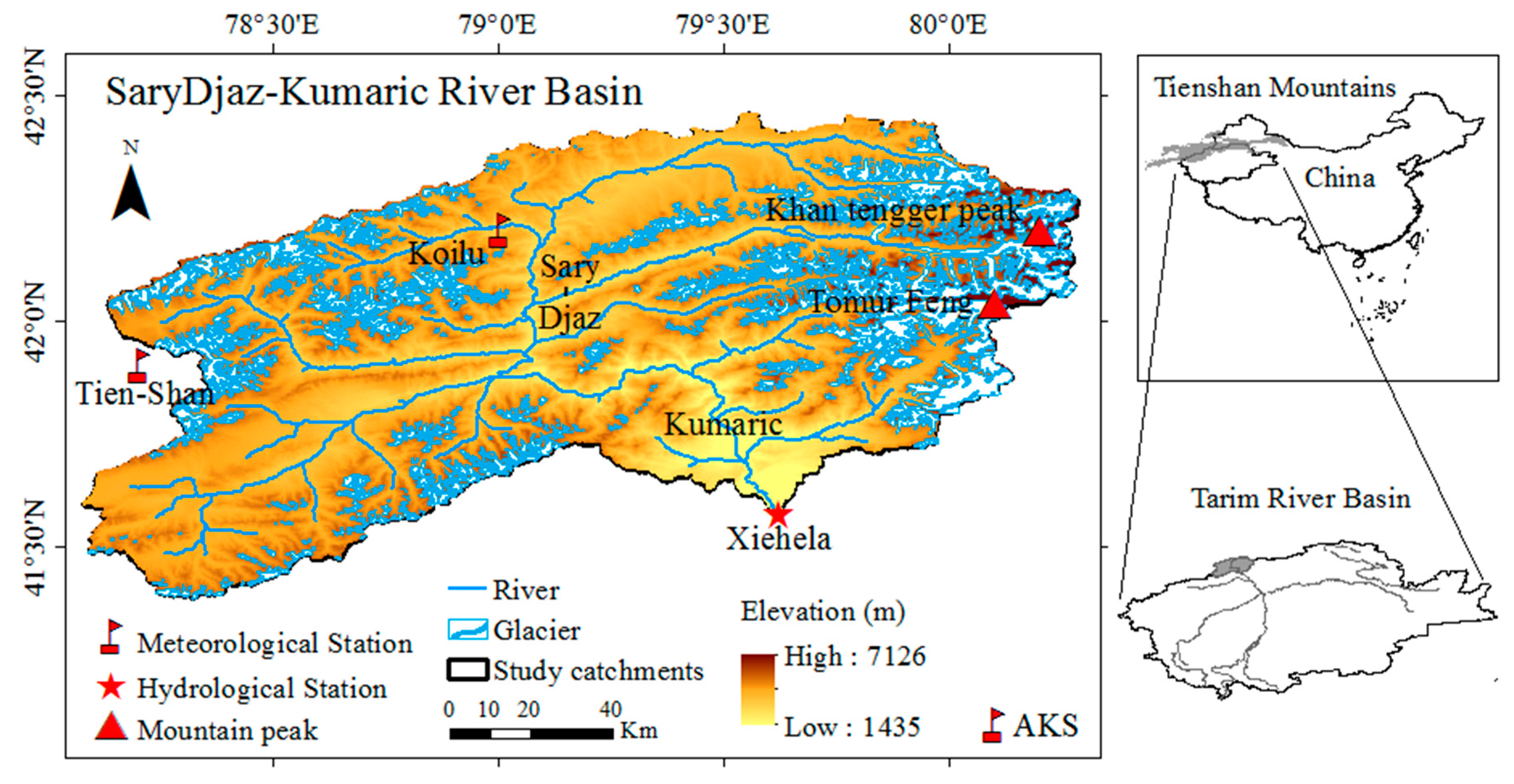
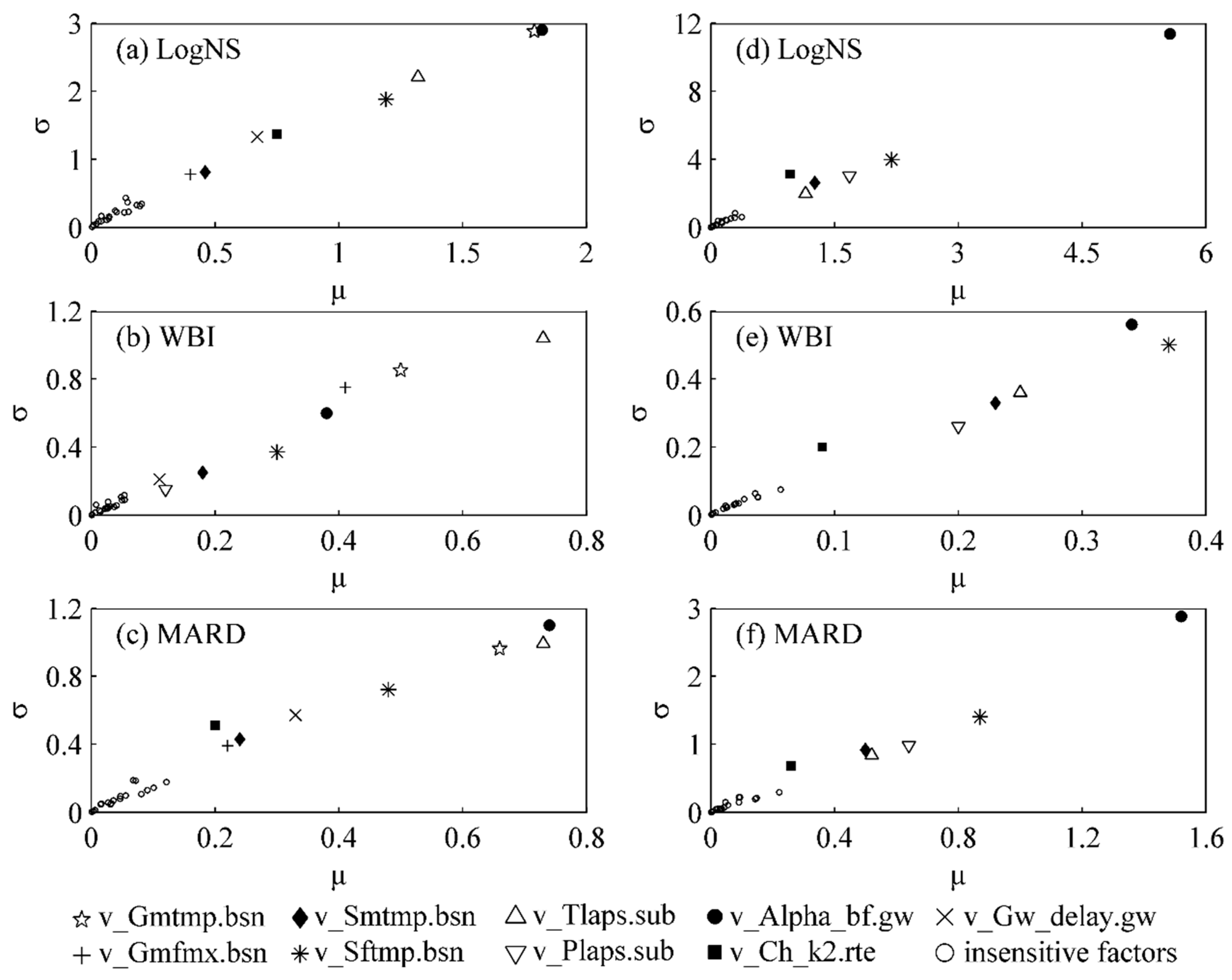

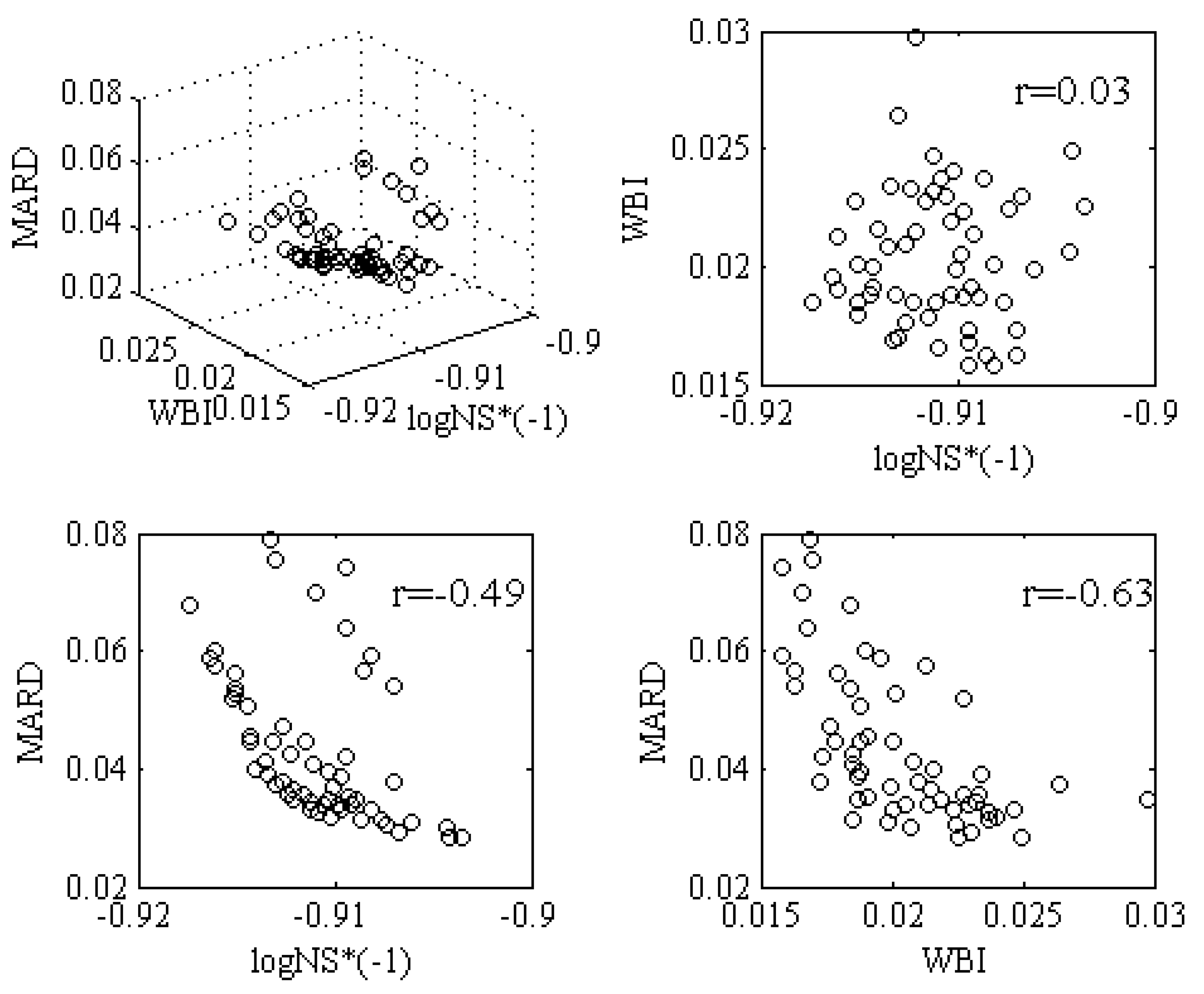
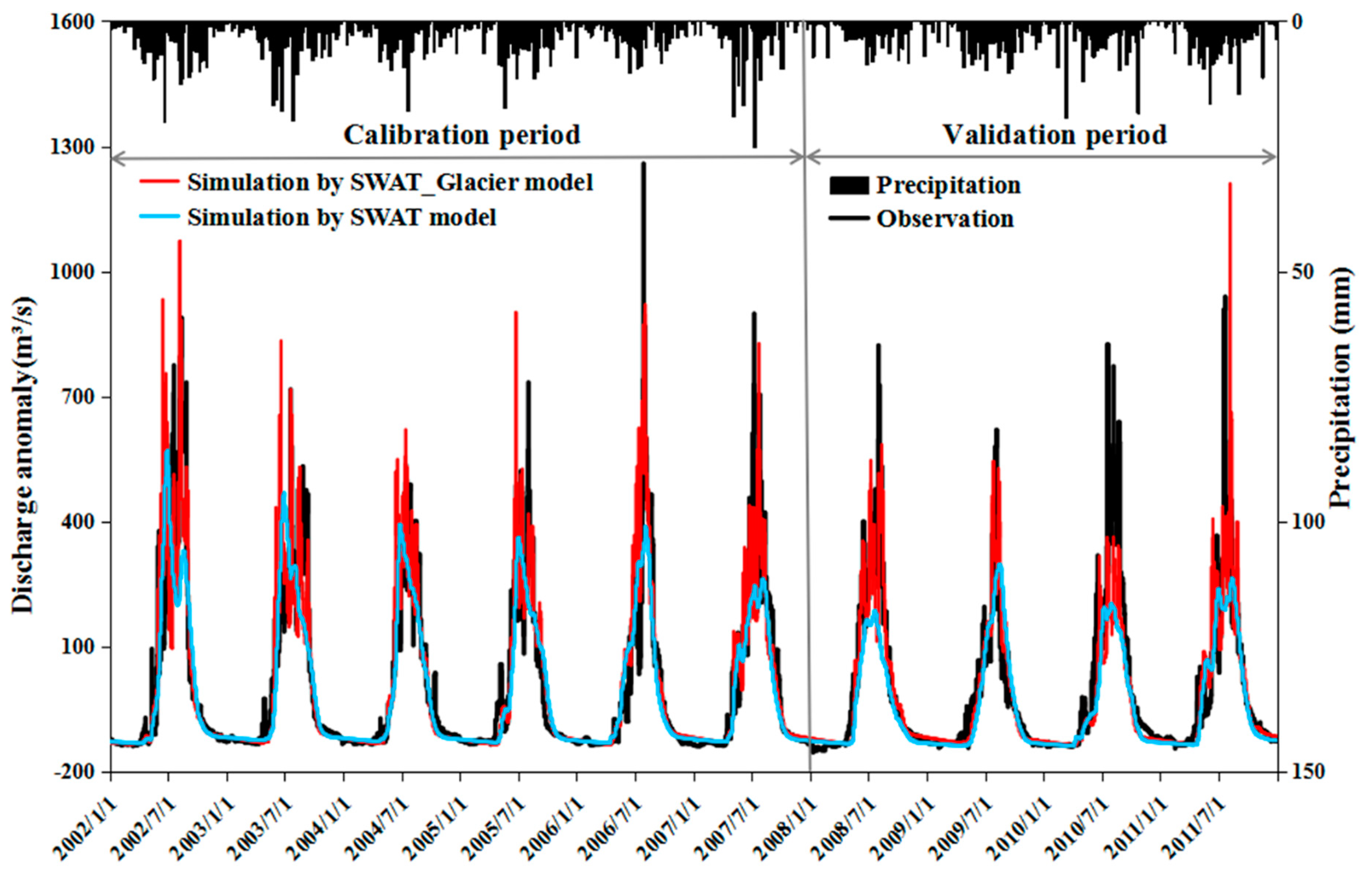
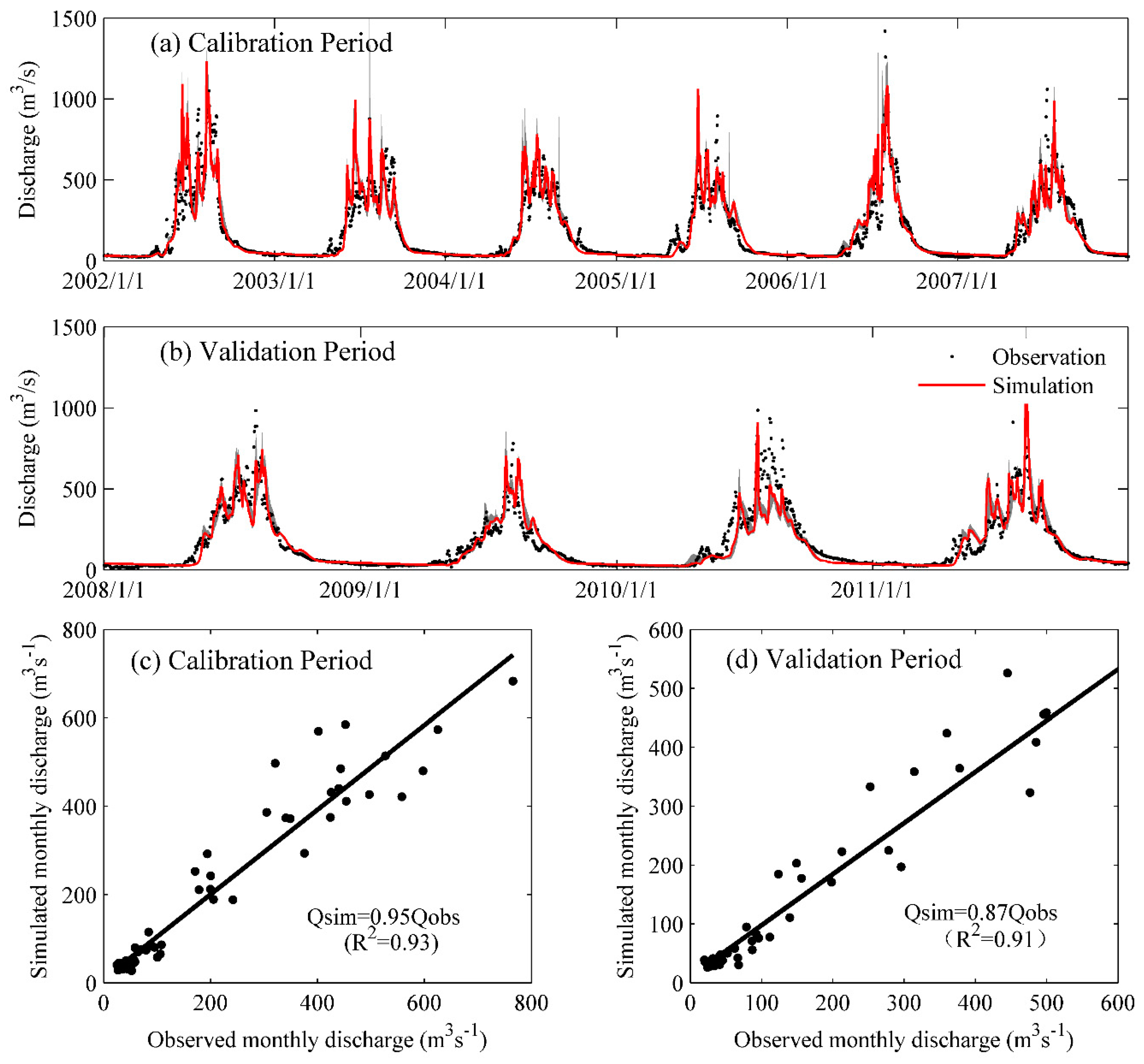
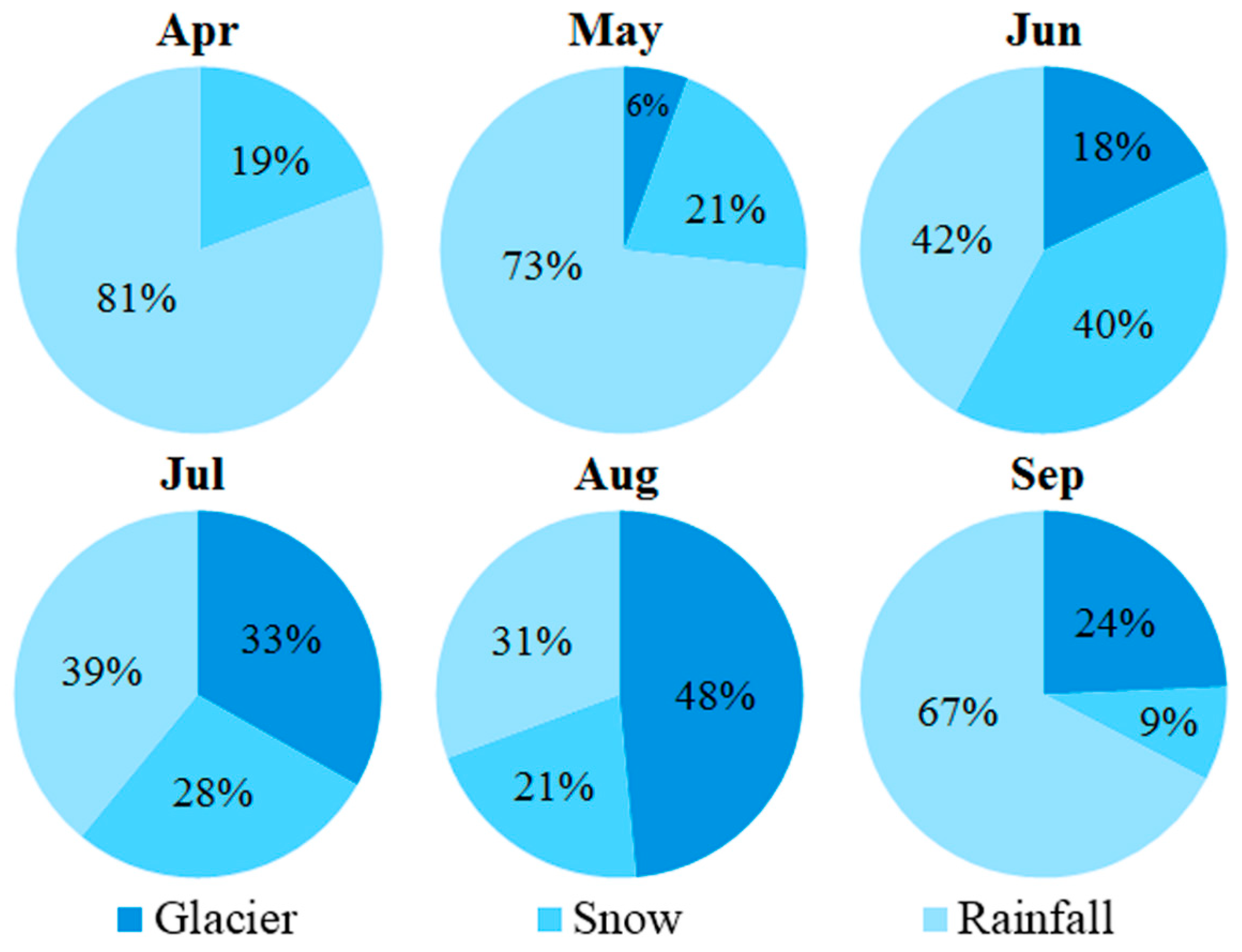
| No. | Factor | Underlying SWAT Parameters | SWAT Parameter Range | Estimated Parameter Values for SWAT Application | Estimated Factor Values for SWAT_Glacier Application |
|---|---|---|---|---|---|
| General SWAT parameter | |||||
| 1 | v__Alpha_bf | Alpha_bf: Baseflow alpha factor | [0, 1] | 0.44 | 0.64 |
| 2 | v__Tlaps | Tlaps: Temperature lapse rate (°C km−1) | [−10, −2] | −4.04 | −6.65 |
| 3 | v__Plaps | Plaps: Precipitation lapse rate (mm km−1) | [0, 200] | 49.98 | 10.61 |
| 4 | v__Ch_k2 | Ch_k2: Effective hydraulic conductivity in main channel alluvium (mm h−1) | [0, 500] | 493.90 | 248.78 |
| 5 | v__Gw_delay | Gw_delay: Groundwater delay time (day) | [0, 500] | 497.95 | 334.42 |
| 6 | r__Slsubbsn | Slsubbsn: Average slope length (m) | [−0.5, 0.5] | −0.46 | −0.49 |
| 7 | v__Ch_k1 | Ch_k1: Effective hydraulic conductivity in tributary channel alluvium (mm h−1). | [0, 300] | 246.43 | 179.86 |
| 8 | r__Sol_k | Sol_kl: Saturated hydraulic conductivity (mm h−1) | [−0.5, 0.5] | 0.49 | 0.49 |
| 9 | r__CN2 | CN2: SCS runoff curve number for moisture condition | [−0.5, 0.5] | −0.06 | −0.36 |
| 10 | v__Gwqmn | Gwqmn: Threshold water level in shallow aquifer for baseflow (mm) | [0, 1000] | 180.78 | 240.48 |
| 11 | v__Gw_revap | Gw_revap: Groundwater ‘revap’ coefficient | [−0.02, 0.2] | - | - |
| 12 | v__Ch_n2 | Ch_n2: Manning’s ‘n’ for main channel (-) | [0, 0.3] | - | - |
| 13 | r__Sol_z | Sol_z: Depth from soil surface to bottom of layer (mm) | [−0.5, 0.5] | - | - |
| 14 | v__Revapmn | Revapmn: Threshold depth of water in shallow aquifer for revap (mm) | [0, 500] | - | - |
| 15 | r__Sol_awc | Sol_awc: Available water capacity of the soil layer (-) | [−0.5, 0.5] | - | - |
| 16 | v__Esco | Esco: Soil evaporation compensation factor (-) | [0, 1] | - | - |
| 17 | v__OV_N | OV_N: Manning’s ‘n’ for overland flow (-) | [0, 30] | - | - |
| 18 | v__Surlag | Surlag: Surface runoff lag time (day) | [0, 24] | - | - |
| 19 | v__Smtmp | Smtmp: Snow melt base temperature(°C) | [−10, 10] | 3.26 | 3.41 |
| 20 | v__Sftmp | Sftmp: Snowfall temperature (°C) | [−10, 10] | 3.33 | 2.59 |
| 21 | v__Smfmx | Smfmx: Snowmelt factor on 21 June (mm °C−1·d−1) | [5, 10] | 8.92 | - |
| 22 | v__Smfmn | Smfmn: Snowmelt factor on 21 December (mm °C−1·d−1) | [0, 5] | - | - |
| 23 | v__Snocovmx | Snocovmx: Water content of snow cover (mm H2O) | [1, 500] | 479.94 | 462.72 |
| Glacier Module Parameters | |||||
| 24 | v__Gmtmp | Gmtmp: Glacier melt base temperature (°C) | [0, 10] | - | 0.61 |
| 25 | v__Gmfmx | Gmfmx: Glacier melt factor on 7 August (mm °C−1·d−1) | [5, 10] | - | - |
| 26 | v__Gmfmn | Gmfmn: Glacier melt factor on 7 February (mm °C−1·d−1) | [0, 5] | - | - |
| Model | Period | Functions | Daily | Monthly | ||||
|---|---|---|---|---|---|---|---|---|
| NS | PBIAS | R2 | NS | PBIAS | R2 | |||
| SWAT | Calibration | Multi-objective | 0.74 | −10.64% | 0.75 | 0.88 | −10.54% | 0.90 |
| SWAT_Glacier | Calibration | Multi-objective | 0.82 | 0.94% | 0.83 | 0.93 | 1.07% | 0.93 |
| SWAT_Glacier | Calibration | LogNS | 0.82 | −15.24% | 0.74 | 0.80 | −15.11% | 0.89 |
| SWAT_Glacier | Calibration | WBI | 0.69 | −1.48% | 0.71 | 0.80 | −1.25% | 0.84 |
| SWAT_Glacier | Calibration | MARD | 0.48 | −19.62% | 0.51 | 0.58 | −19.39% | 0.63 |
| SWAT | Validation | Multi-objective | 0.67 | −21.49% | 0.73 | 0.78 | −21.43% | 0.86 |
| SWAT_Glacier | Validation | Multi-objective | 0.79 | −5.40% | 0.80 | 0.91 | −5.36% | 0.91 |
| SWAT_Glacier | Validation | LogNS | 0.71 | −17.24% | 0.68 | 0.73 | −16.72% | 0.82 |
| SWAT_Glacier | Validation | WBI | 0.57 | −8.40% | 0.59 | 0.69 | −7.79% | 0.73 |
| SWAT_Glacier | Validation | MARD | 0.39 | −29.17% | 0.49 | 0.49 | −28.87% | 0.61 |
© 2019 by the authors. Licensee MDPI, Basel, Switzerland. This article is an open access article distributed under the terms and conditions of the Creative Commons Attribution (CC BY) license (http://creativecommons.org/licenses/by/4.0/).
Share and Cite
Ji, H.; Fang, G.; Yang, J.; Chen, Y. Multi-Objective Calibration of a Distributed Hydrological Model in a Highly Glacierized Watershed in Central Asia. Water 2019, 11, 554. https://doi.org/10.3390/w11030554
Ji H, Fang G, Yang J, Chen Y. Multi-Objective Calibration of a Distributed Hydrological Model in a Highly Glacierized Watershed in Central Asia. Water. 2019; 11(3):554. https://doi.org/10.3390/w11030554
Chicago/Turabian StyleJi, Huiping, Gonghuan Fang, Jing Yang, and Yaning Chen. 2019. "Multi-Objective Calibration of a Distributed Hydrological Model in a Highly Glacierized Watershed in Central Asia" Water 11, no. 3: 554. https://doi.org/10.3390/w11030554
APA StyleJi, H., Fang, G., Yang, J., & Chen, Y. (2019). Multi-Objective Calibration of a Distributed Hydrological Model in a Highly Glacierized Watershed in Central Asia. Water, 11(3), 554. https://doi.org/10.3390/w11030554







